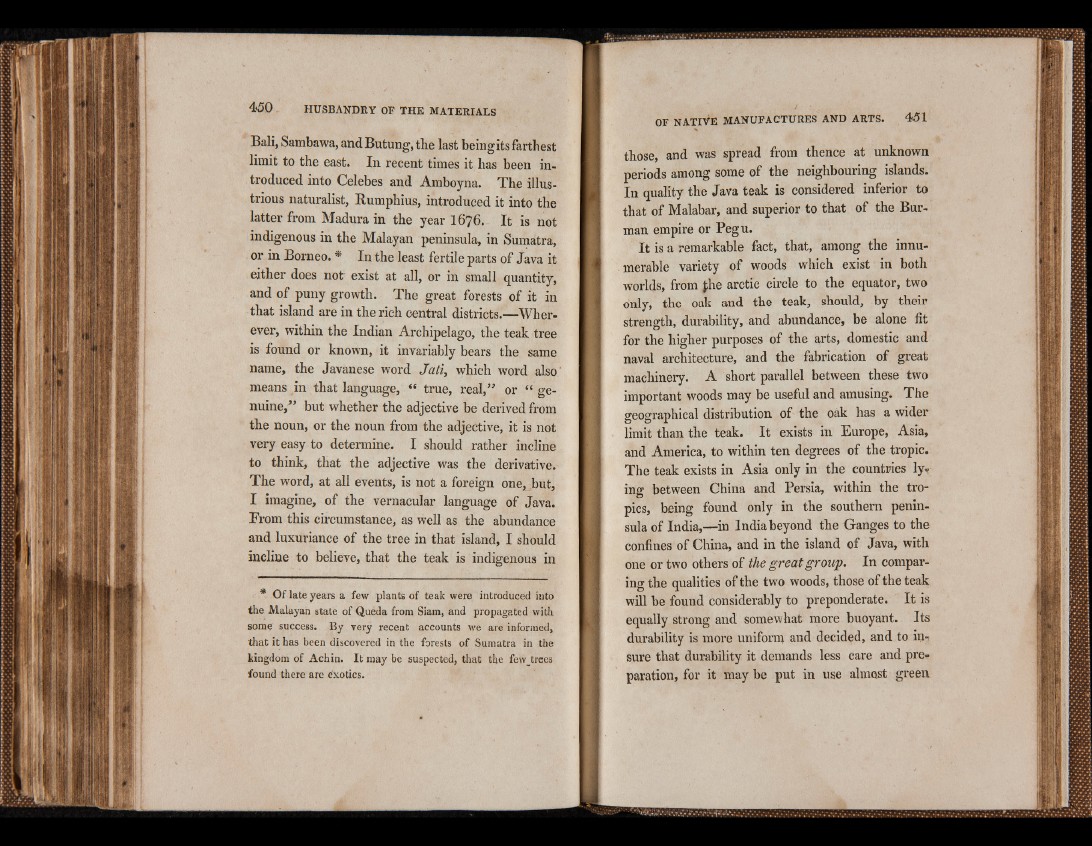
Bali, Sambawa, and Butung, the last beingits farthest
limit to the east. In recent times it has been introduced
into Celebes and Amboyna. The illustrious
naturalist, Rumphius, introduced it into the
latter from Madura in the year I 676. It is not
indigenous in the Malayan peninsula, in Sumatra,
or in Borneo. * In the least fertile parts of Java it
either does not exist at all, or in small quantity,
and of puny growth. The great forests of it in
that island are in the rich central districts.—Wherever,
within the Indian Archipelago, the teak tree
is found or known, it invariably bears the same
name, the Javanese word Jati, which word also
means in that language, “ true, real,” or “ genuine,”
but whether the adjective be derived from
the noun, or the noun from the adjective, it is not
very easy to determine. I should rather incline
to think, that the adjective was the derivative.
The word, at all events, is not a foreign one,L.but,
I imagine, of the vernacular language of Java.
From this circumstance, as well as the abundance
and luxuriance of the tree in that island, I should
incline to believe, that the teak is indigenous in
* Of late years a few plants of teak were introduced into
the Malayan state of Queda from Siam, and propagated with
some success. By very recent accounts we are informed,
that it has been discovered in the forests of Sumatra in the
kingdom of Achin. I t may be suspected, that the fewjrees
found there are exotics.
those, and was spread from thence at unknown
periods among some of the neighbouring islands.
In quality the Java teak is considered inferior to
that of Malabar, and superior to that of the Bur-
man empire or Pegu.
It is a remarkable fact, that, among the innumerable
variety of woods which exist in both
worlds, from Jhe arctic circle to the equator, two
only, the oak and the teak, should, by their
strength, durability, and abundance, be alone fit
for the higher purposes of the arts, domestic and
naval architecture, and the fabrication of great
machinery. A short parallel between these two
important woods may be useful and amusing. The
geographical distribution of the oak has a wider
limit than the teak. It exists in Europe, Asia,
and America, to within ten degrees of the tropic.
The teak exists in Asia only in the countries lyr
ing between China and Persia, within the tropics,
being found only in the southern peninsula
of India,—in India beyond the Ganges to the
confines of China, and in the island of Java, with
one or two others of the great group. In comparwill
be found considerably to preponderate. It is
equally strong and somewhat more buoyant. Its
durability is more uniform and decided, and to im
sure that durability it demands less care and preparation,
for it may be put in use almost green